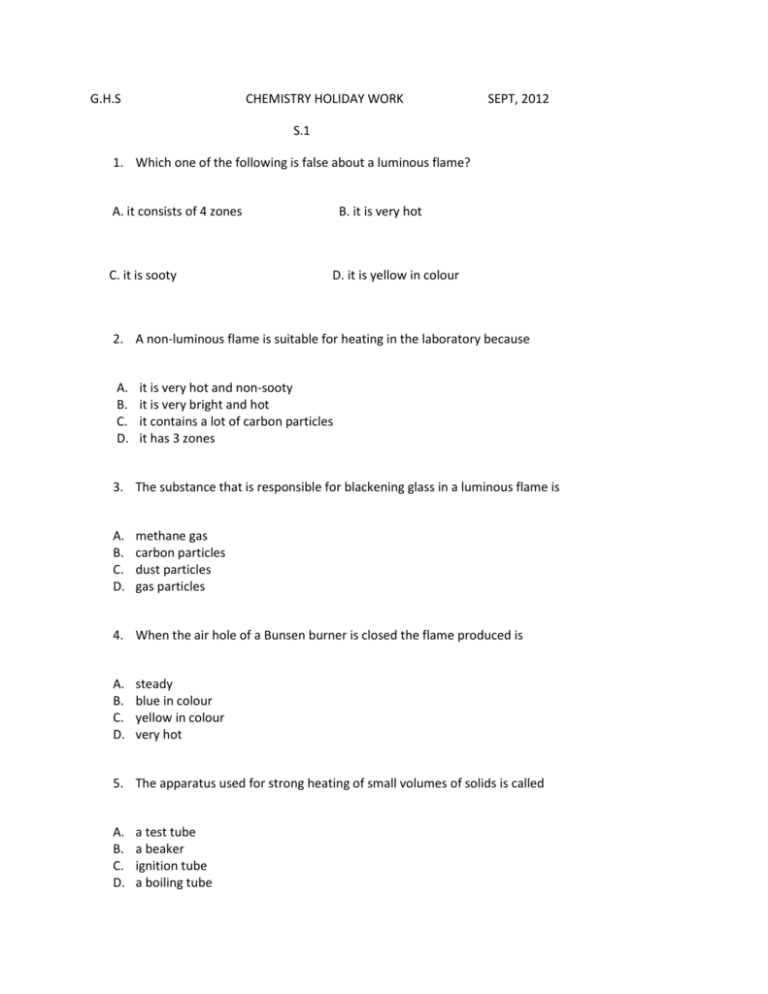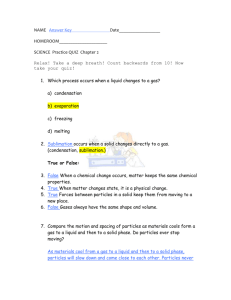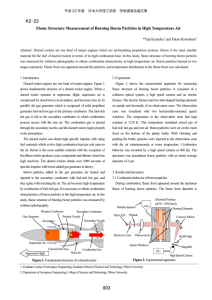1343902505.
advertisement

G.H.S CHEMISTRY HOLIDAY WORK SEPT, 2012 S.1 1. Which one of the following is false about a luminous flame? A. it consists of 4 zones C. it is sooty B. it is very hot D. it is yellow in colour 2. A non-luminous flame is suitable for heating in the laboratory because A. B. C. D. it is very hot and non-sooty it is very bright and hot it contains a lot of carbon particles it has 3 zones 3. The substance that is responsible for blackening glass in a luminous flame is A. B. C. D. methane gas carbon particles dust particles gas particles 4. When the air hole of a Bunsen burner is closed the flame produced is A. B. C. D. steady blue in colour yellow in colour very hot 5. The apparatus used for strong heating of small volumes of solids is called A. B. C. D. a test tube a beaker ignition tube a boiling tube 6. Which of the following results into a physical change? A. B. C. D. heating of ammonium chloride burning of a candle rusting of iron heating of copper 7. A. B. C. D. Particles of matter possess the greatest kinetic energy when in: gaseous state liquid state solid state molten state 8. The following gases exist as diatomic molecules except: A. B. C. D. nitrogen oxygen hydrogen helium 9. The force of attraction between particles of different kind is called: A. B. C. D. Adhesion force Repulsion force Cohesion force Gravitation force 10. According to Dalton’s atomic theory, matter is made up of countless small particles called: A. B. C. D. molecules atoms elements ions 11. Which one of the following statements is not correct? A. All atoms are electrically neutral B. Heating of a liquid increases the kinetic energy of its particles C. The force of attraction in solids is uniform for all particles D. None of the above 12. A volatile liquid is one which A. B. C. D. evaporates easily less dense than water has a high boiling point is denser than water 13. The apparatus used to scoop small volumes of solids from bottles in the laboratory is called a: A. B. C. D. glass rod stirring rod spatula watch glass 14. Which one of the following is a mixture? A. B. C. D. copper sodium bronze iron 15. The three fundamental particles of an atom are: A. B. C. D. electrons, neutrons and protons electrons, neutrons and deuterium protonium, deuterium and electrons proton, protonium and neutron 16. The chemical symbol of copper is: A. B. C. D. Co Cp Cu Cr 17. When small particles are strongly illuminated and viewed through a microscope, they appear to be moving in a random zigzag motion. This is because A. B. C. D. of the effect of bright light the particles are warm the particles are bombarded by air particles the air particles are knocked around by the smoke particles 18. The region of a non-luminous gas that contains a lot of un burnt gas is: A. B. C. D. The pale blue or purple zone The cool inner zone The blue zone The green or blue zone 19. A gas X has molecular formula X3. X can be described as A. B. C. D. polyatomic diatomic tri-atomic monatomic 20. This element is a non-metal but conducts electricity like metals: A. B. C. D. Plastic Graphite Sulphur Phosphorous 21. (a) Define the following terms: (i) Physical change (ii) Chemical change (b) Give four differences between a physical and a chemical change: Physical change Chemical change 1. 1. 2. 2. 3. 3. 4. 4. ( c ) State whether the following are physical or chemical changes: (i) Rusting of iron…………………………………………………… (ii) Combustion of petrol……………………………………………. (iii) Burning of a candle……………………………………………… (iv) Photosynthesis…………………………………………………. (v) Magnetization of iron…………………………………………. (vi) Melting of candle wax………………………………………… 22 (a) Draw a well labeled diagram of: (i) Luminous flame (ii) Non-luminous flame (b) Give four ways in which a luminous flame differs from a non-luminous flame 1. 2. 3. 4. 23. (a) Define the following terms: (i) Matter (ii) Cohesion (b) What are the three states of matter? (i)……………………………………………….. (ii)……………………………………………… (iii)……………………………………………… ( c ) Give three ways in which the particles of solids differ from those of gases 1. 2. 3.









